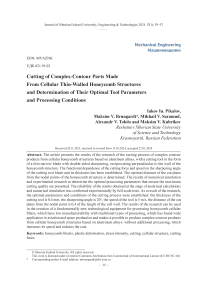Cutting of complex-contour parts made from cellular thin-walled honeycomb structures and determination of their optimal tool parameters and processing conditions
Автор: Pikalov Ia.iu., Brungardt M.V., Saramud M.V., Tololo A.V., Kubrikov M.V.
Журнал: Журнал Сибирского федерального университета. Серия: Техника и технологии @technologies-sfu
Рубрика: Исследования. Проектирование. Опыт эксплуатации
Статья в выпуске: 1 т.17, 2024 года.
Бесплатный доступ
The article presents the results of the research of the cutting process of complex contour products from cellular honeycomb structures based on aluminum alloys, with a cutting tool in the form of a thin narrow blade with double-sided sharpening, reciprocating perpendicular to the wall of the honeycomb structure. The functional dependence of the cutting force and speed on the sharpening angle of the cutting tool blade and its thickness has been established. The optimal distance of the cut plane from the nodal points of the honeycomb structure is determined. The results of numerical simulation and experimental research to determine the optimal processing parameters that ensure the maximum cutting quality are presented. The reliability of the results obtained at the stage of analytical calculations and numerical simulation was confirmed experimentally by full-scale tests. As a result of the research, the optimal parameters and conditions of the cutting process were established: the thickness of the cutting tool is 0.4 mm, the sharpening angle is 20°, the speed of the tool is 5 m/s, the distance of the cut plane from the nodal point is 0.4 of the length of the cell wall. The results of the research can be used in the creation of a fundamentally new technological equipment for processing honeycomb cellular fillers, which have low manufacturability with traditional types of processing, which has found wide application in aviation and space production and makes it possible to produce complex-contour products from cellular honeycomb structures based on aluminum alloys. without additional processing, which increases its speed and reduces the cost.
Honeycomb blocks, plastic deformation, stress intensity, cutting, cellular structure, cutting force
Короткий адрес: https://sciup.org/146282838
IDR: 146282838 | УДК: 621.91.02
Список литературы Cutting of complex-contour parts made from cellular thin-walled honeycomb structures and determination of their optimal tool parameters and processing conditions
- Wadley H. N. G. Multifunctional periodic cellular metals, Phil. Trans. R. Soc. A., 2005, 364(1838), 31-68.
- Wang F., Wang Y. Investigate on milling force of cryogenic cooling processing aluminum honeycomb treatedby ice fixation, IntJAdvManufTechnol., 2018, 98(5-8), 1253-1265.
- Paik J. K. Cutting of a Longitudinally Stiffened Plate by a Wedge, J of Ship Research, 1994, 38(04), 340-348.
- Qiu K. et al. Study on the cutting force in machining of aluminum honeycomb core material, Composite Structures, 2017, 164, 58-67.
- Xiang D. et al. Ultrasonic longitudinal-torsional vibration-assisted cutting of Nomex® honeycomb-core composites, IntJAdvManufTechnol., 2018, 100(5-8), 1521-1530.
- Yi Jin S., Altenhof W., Kapoor T. An experimental investigation into the cutting deformation mode of AA6061-T6 roundextrusions, Thin-Walled Structures, 2006, 44(7), 773-786.
- Zarrouk T. et al. Analysis of friction and cutting parameters when milling honeycomb composite structures, Advances inMechanicalEngineering, 2021, 13(7), 168781402110348.
- Lu G., Yu T. X., Huang X. Energy absorption of metallic structures involving ductile tearing, IJVD, 2005, 37(2/3), 224.
- Jones N., Wierzbicki T. International Symposium on Structural Crashworthiness and Failure (3rd) Held in Liverpool, United Kingdom on April 14-16, 1993, 13(2). Special Issue, NASA STI/Recon Technical Report, 1993, 243.
- Lu G., Calladine C. R. On the cutting of a plate by a wedge, Int J of Mechanical Sciences, 1990, 32(4), 293-313.
- Zheng Z. M., Wierzbicki T. A theoretical study of steady-state wedge cutting through metal plates, Int J Fract., 1996, 78(1), 45-66.
- Imonsen B. C., Wierzbicki T. Plasticity, fracture and friction in steady state plate, Int J of ImpactEngineering, 1997, 19(8), 667-691.
- Yi Jin S., Altenhof W., Kapoor T. An experimental investigation into the cutting deformation mode of AA6061-T6 round extrusions, Thin-Walled Structures, 2006, 44(7), 773-786.
- Jin S. Y., Altenhof W. Experimental observations of AA6061-T6 round extrusions under a cutting deformation mode with a deflector, Int J of Crashworthiness, 2008, 13(2), 127-138.
- Jin S. Y., Altenhof W. An analytical model on the steady-state deformation of circular tubes under an axial cutting deformation mode, Int J of Solids and Structures, 2011, 48(2), 269-279.
- Bondy M. et al. Finite element modeling of a novel cutting deformation mode of AA6061-T6 tubes employing higher order Lagrangian element formulations, Int J of Impact Engineering, 2017, 110, 288-298.
- Yip-Hoi D. et al. Material Stiffness and Cutting Parameters for Honeycomb Aluminum Sandwich Panel: a Comparison with Bulk Material, ProcediaManufacturing, 2019, 34, 385-392.
- Zhou Q., Mayer R. R. Characterization of Aluminum Honeycomb Material Failure in Large Deformation Compression, Shear, and Tearing, J of Engineering Materials and Technology, 2002, 124(4), 412-420.
- Ashab A. et al. Experimental investigation of the mechanical behavior of aluminum honeycombs under quasi-static and dynamic indentation, Materials & Design, 2015, 74, 138-149.
- Ashab A. S. M. et al. Finite Element Analysis of Aluminum Honeycombs Subjected to Dynamic Indentation and Compression Loads, Materials, 2016, 9(3), 162.
- Liu Y. et al. Testing and modeling tearing and air effect of aluminum honeycomb under out-of-plane impact loading, IntJoflmpactEngineering, 2020, 135, 103402.
- Li X. et al. Influence of cell size effect on the vertical cutting of hexagonal thin-walled honeycombs by parallel blades, Thin-Walled Structures, 2020, 157, 107137.
- Confalonieri F., Ghisi A., Perego U. Blade cutting of thin walled structures by explicit dynamics finite elements, Meccanica, 2017, 53(6), 1271-1289.


